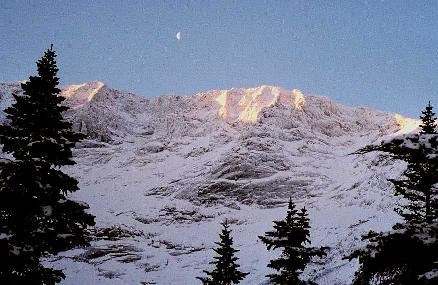
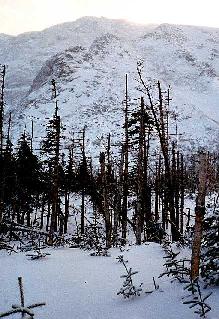 The day started by me saying "Guys is 5 o'clock, get up"..."Guys is
5:15 get up"..."Guys is 5:45 get up" (then Bill responds "you liar, is
5:30"). This proceeded for a long time. Our fake alpine start was
delayed by our laziness or cozy sleeping bags (at least for Bill and
I, Mike and Robert were ready 30 minutes before us). Theoretically we
should have been on the trail at 6 or so am. We ended up starting at
8am (of course, I had secretly made accounted for this, so we were not
late according to my internal time :-). One of the difficulties is
that in a two-person tent is difficult for both people to get dress at
the same time. Bill and I played reverse-strip-poker. I would say
"Ok Bill, I have my thermal underwear on, now is your turn", "he would
put his on, and then another layer", of course while he is doing this
I am resting or sleeping, "is your turn now", then I would put on a
fleece layer, and raise him a pair of socks.... This went on for 40
minutes until we were dressed. Then came the boots. Pretty much only
one person can put on the boots at a time if done at the edge of the
tent (this allowed me to sleep 15 extra minutes!). We had 4 pop tarts
for breakfast to save the time of cooking. Before leaving, we hung
our food on the Bear line. Although bears are (suppose to be) asleep,
there are weasels that would eat your food if left outside.
The day started by me saying "Guys is 5 o'clock, get up"..."Guys is
5:15 get up"..."Guys is 5:45 get up" (then Bill responds "you liar, is
5:30"). This proceeded for a long time. Our fake alpine start was
delayed by our laziness or cozy sleeping bags (at least for Bill and
I, Mike and Robert were ready 30 minutes before us). Theoretically we
should have been on the trail at 6 or so am. We ended up starting at
8am (of course, I had secretly made accounted for this, so we were not
late according to my internal time :-). One of the difficulties is
that in a two-person tent is difficult for both people to get dress at
the same time. Bill and I played reverse-strip-poker. I would say
"Ok Bill, I have my thermal underwear on, now is your turn", "he would
put his on, and then another layer", of course while he is doing this
I am resting or sleeping, "is your turn now", then I would put on a
fleece layer, and raise him a pair of socks.... This went on for 40
minutes until we were dressed. Then came the boots. Pretty much only
one person can put on the boots at a time if done at the edge of the
tent (this allowed me to sleep 15 extra minutes!). We had 4 pop tarts
for breakfast to save the time of cooking. Before leaving, we hung
our food on the Bear line. Although bears are (suppose to be) asleep,
there are weasels that would eat your food if left outside.
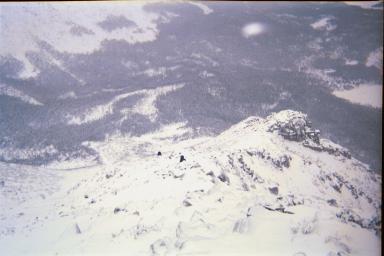 We checked out at 8am, and donned our snowshoes. Being the only ones
in the mountain also means that you have to break more trail. The
first quarter mile is just a flat walk until the beginning of the steep
unrelenting ascent to gain the Cathedral Ridge (1.75 miles and 2500 ft
elevation gain to the summit). The trail start with a 40-degree snow
climb. Here, we learned the basics of steep snow shoeing. It is
actually pretty impressive the steepness of things you can snow shoe.
About and hour or two later we reached the point where snow shoeing was
not necessary and switched to crampons. Here the memories of my summer
hike up this trail began to come back. This winter trail requires
some scrambling beyond the usual high-step. You had to do mantels,
counter pressures, pull ups, stems. All this while carrying winter
day packs with emergency gear!. Although overall it was not so bad,
there were only 2 or 3 times where if I had slipped I would have
broken any ones, other than that most falls would have produced cuts
and bruises.
We checked out at 8am, and donned our snowshoes. Being the only ones
in the mountain also means that you have to break more trail. The
first quarter mile is just a flat walk until the beginning of the steep
unrelenting ascent to gain the Cathedral Ridge (1.75 miles and 2500 ft
elevation gain to the summit). The trail start with a 40-degree snow
climb. Here, we learned the basics of steep snow shoeing. It is
actually pretty impressive the steepness of things you can snow shoe.
About and hour or two later we reached the point where snow shoeing was
not necessary and switched to crampons. Here the memories of my summer
hike up this trail began to come back. This winter trail requires
some scrambling beyond the usual high-step. You had to do mantels,
counter pressures, pull ups, stems. All this while carrying winter
day packs with emergency gear!. Although overall it was not so bad,
there were only 2 or 3 times where if I had slipped I would have
broken any ones, other than that most falls would have produced cuts
and bruises.
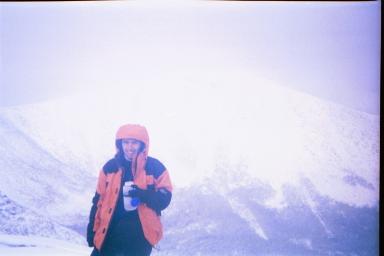 I queried the comfort level of all team members, to make sure they
were comfortable scrambling up this trail. Fortunately (or so I
think) they would have told me otherwise, if so they felt. We reached
the upper section of the mountain a little before noon. This upper
section is not as steep as before; just a little bit more exposed. At
this point, we all had a full wind ensemble. Unfortunately, goggles
are very had to keep from fogging (or at least cheap ones). I
honestly try to keep mine on, but they were fogging so much that I had
taken them off. Before they fogged, I was barely able to follow just
the broken steps in front of me. The wind was not bad, perhaps 25 or
less miles per hour steady with gusts of 40 mph. We pressed on and
finally summitted at 1pm!!! We had reached the end of the Appalachian
Trail, in full winter conditions. We had achieved the first half of
our trips objective, so we were happy (the second half, is returning
unscathed).
I queried the comfort level of all team members, to make sure they
were comfortable scrambling up this trail. Fortunately (or so I
think) they would have told me otherwise, if so they felt. We reached
the upper section of the mountain a little before noon. This upper
section is not as steep as before; just a little bit more exposed. At
this point, we all had a full wind ensemble. Unfortunately, goggles
are very had to keep from fogging (or at least cheap ones). I
honestly try to keep mine on, but they were fogging so much that I had
taken them off. Before they fogged, I was barely able to follow just
the broken steps in front of me. The wind was not bad, perhaps 25 or
less miles per hour steady with gusts of 40 mph. We pressed on and
finally summitted at 1pm!!! We had reached the end of the Appalachian
Trail, in full winter conditions. We had achieved the first half of
our trips objective, so we were happy (the second half, is returning
unscathed).
After only having been at the summit for 5 minutes, we proceeded down. Reaching the summit is only half of the way. It is incredible how fast the wind erases or makes hard to recognize our footprints. We walked half a mile on the summit ridge and saddle plateau until we reached the beginning of saddle trail (from summit down saddle trail is 2.2 miles, 2500 elev. loss). This walk is gorgeous because there are no trees to block your views, and it is really an expanse terrain. Right before heading down we had some tea. I have not mentioned one of the luxuries (or perhaps a real good item) of this trip, was Robert's Thermos. It keeps water or tea hot for really LONG periods of time. Robert was the trip mom, taking care of us, and feeding us tea throughout the whole trip.
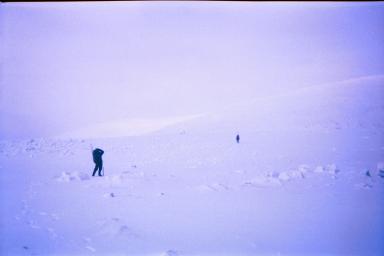 The beginning of the saddle trail is very impressive, is about a 45-50
degree slope!!. My first words where "Whoa, we are going to go down
this?" and my second words where "how is everyone's self arrest
technique?"; I will not describe in this trip report the answers
gotten. We proceeded walking down carefully this slope. Fortunately
for us, there was little avalanche danger as the snow was very firm.
After half way down the saddle, I decided that it was safe to butt
glissade. So I took off my crampons (as it is well known that any
form of glissading with crampons is dangerous to the ankles and
foolish) and finished the steep part of the descent in no time (I
should have started to glissade sooner).
The beginning of the saddle trail is very impressive, is about a 45-50
degree slope!!. My first words where "Whoa, we are going to go down
this?" and my second words where "how is everyone's self arrest
technique?"; I will not describe in this trip report the answers
gotten. We proceeded walking down carefully this slope. Fortunately
for us, there was little avalanche danger as the snow was very firm.
After half way down the saddle, I decided that it was safe to butt
glissade. So I took off my crampons (as it is well known that any
form of glissading with crampons is dangerous to the ankles and
foolish) and finished the steep part of the descent in no time (I
should have started to glissade sooner).
The end of the slide, asked for some route finding for getting back on the trail (there are no cairns in the 500 feet slide...) Fortunately I spotted some broken trail ahead of us (of course Mike has actually seen a blaze and orange ribbon on a tree some minutes earlier, and hence secured the sure way to the trail much before me). We got back to camp at about 3:20pm.
The nice thing about winter camping are the early dinners and early bed times. As soon as we got back, gorging time started. Although I was not really tired, I was hungry, I professed to the cook Robert, what could possibly become one of the trip's quote "I would eat anything you put in my mouth." Ahh nothing like gorging after a long day hike. Dinner was rice and mashed potatoes; this was really a treat. The Winter Hiking Cuisine rates it "A wonderful after-hike meal, to make you lick your fingers", it was delicious (I would say that no matter what dinner would have been, I still would have found it delicious). Curiously, the butter was missing. We could not locate the butter, although we looked everywhere. Fortunately we had done the hard part of the trip. I would like to point out that butter is sooo good, you just drop bars of it into your boiling pot, it does wonders for heat generation and a warm toasty sleep (we pretty much used a bar or two per day before losing it).
It was time now to plan the next days activities before talking to the ranger and heading to bed. The hike had been arduous, but I we had saved juice for the next day. The views of the classic knife edge called to me; Robert had also expressed interest. Mike and Bill were pleased with the day's success and were not really eager for a long technical day. After discussing the options for other hikes and making sure everyone was happy, we decided for the next day to climb up to Pamola Peak via the Dudley trail. The Dudley trail is somewhat shorter than Cathedral and has a little less elevation gain (1.5 miles, 2000 feet evel. gain); but still is very sustained and steep. There Robert and I, if conditions were right, would press on over knife edge; and Mike and Bill would return back to base camp.
The ranger cabin was again warm (actually a little too warm for my taste); and we sweated a bit. We brought the plan to the ranger. The knife edge is the ridge connecting Pamola Peak to Baxter Peak; it is really a beautiful ridge. The way I have been recommended of traversing it, is from Pamola to Baxter, since most of the hike/climb would be uphill (there is a 300 feet elevation gain from Pamola to Baxter). The most difficult part, fortunately, is at the beginning; it is going from Pamola to Chimney Peak. These peaks are about 100 feet a stone throw away from each other, but with a 60 feet notch in between them. This notch is semi-technical, some people do it with rope, and some people without it. The steepest part is going up to Chimney.
The first order of business was discussing the technical gear we had for the climb. I felt slightly embarrassed since I really just brought a _tiny_ rock rack and ropes (when I brought the gear I was really thinking of perhaps doing some ice top roping). The ranger was somewhat hesitant, but approved the idea assuming we used good judgment, and added some pointers on ways of protecting the route with natural gear (like draping the rope over rocks such that rocks could catch the rope on a fall). Additionally the ranger considering that the knife edge is a technical plan, okayed the two two-person team plans. I it my impression that they prefer four people groups for hiking, and allow two person groups for technical climbs (for safety reasons since a two person team is faster). The next order of business is setting up estimated departure and turn around times. I think this is very important to set at the beginning and to stick to them. It really gives you a foolproof deterministic way to make trips somewhat safer. For administrative purposes we divided into two groups, Team A: Mike and Bill; and Team B: Robert and Hector. We made a commitment time for knife edge of 11am, that is by that time we would decide to go for it or not; and turn around time of 1pm if we did not reach Pamola. In addition to planning our last day's climb, we also got the scoop on P&P, park and policy. We then retreated back to our artificial shelters, for the next day's alpine start.